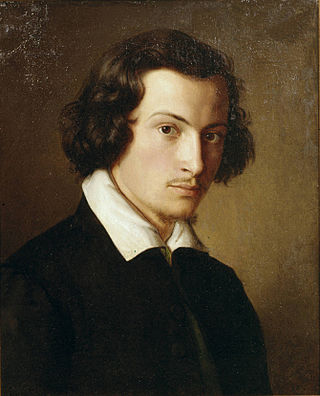
Edvard Munch was a Norwegian painter. His 1893 work The Scream has become one of Western art's most acclaimed images.

Munch Museum, marketed as Munch since 2020, is an art museum in Bjørvika, Oslo, Norway dedicated to the life and works of the Norwegian artist Edvard Munch.

Philipp Veit was a German Romantic painter and one of the main exponents of the Nazarene movement. It is to Veit that the credit of having been the first to revive the nearly forgotten technique of fresco painting is due.

The Scream is a composition created by Norwegian artist Edvard Munch in 1893. The Norwegian name of the piece is Skrik (Scream), and the German title under which it was first exhibited is Der Schrei der Natur. The agonized face in the painting has become one of the most iconic images in art, seen as symbolizing the anxiety of the human condition. Munch's work, including The Scream, had a formative influence on the Expressionist movement.

Madonna is the usual title given to several versions of a composition by the Norwegian expressionist painter Edvard Munch showing a bare-breasted half-length female figure created between 1892 and 1895 using oil paint on canvas. He also produced versions in print form.

The National Museum is a museum in Oslo, Norway which holds the Norwegian state's public collection of art, architecture, and design objects. The collection totals over 400,000 works, amongst them the first copy of Edvard Munch's The Scream from 1893. The museum is state-owned and managed by the Norwegian Ministry of Culture.

The Städel, officially the Städelsches Kunstinstitut und Städtische Galerie, is an art museum in Frankfurt, with one of the most important collections in Germany. The museum is located at the Museumsufer on the Sachsenhausen bank of the River Main. The Städel Museum owns 3,100 paintings, 660 sculptures, more than 4,600 photographs and more than 100,000 drawings and prints. It has around 7,000 m2 (75,000 sq ft) of display and a library of 115,000 books.

The Sick Child is the title given to a group of six paintings and a number of lithographs, drypoints and etchings completed by the Norwegian artist Edvard Munch between 1885 and 1926. All record a moment before the death of his older sister Johanne Sophie (1862–1877) from tuberculosis at 15. Munch returned to this deeply traumatic event repeatedly in his art over a period of more than 40 years. In the works, Sophie is typically shown on her deathbed accompanied by a dark-haired, grieving woman assumed to be her aunt Karen; the studies often show her in a cropped head shot. In all the painted versions Sophie is sitting in a chair, obviously suffering from pain, propped by a large white pillow, looking towards an ominous curtain likely intended as a symbol of death. She is shown with a haunted expression, clutching hands with a grief-stricken older woman who seems to want to comfort her but whose head is bowed as if she cannot bear to look the younger girl in the eye.

Hjalmar Eilif Emanuel Peterssen was a Norwegian painter. He is most commonly associated with his landscapes and portraits. He gained early recognition for the history painting Christian II signing the Death Warrant of Torben Oxe and established himself as one of Norway's foremost portrait painters, with portraits of, among others, Henrik Ibsen and Edvard Grieg. He also became known for his landscape paintings, and became part of the artist circle known as the Skagen Painters. He also became known for his design in 1905 of Norway's national coat of arms with the Norwegian lion, which was used by the government and the royal house. The design is still used in the royal coat of arms and the royal flag.

Ludvig Karsten was a Norwegian painter. He was a neo-impressionist influenced by Edvard Munch, Henri Matisse and contemporary French painting. He first participated at the Autumn exhibition in Kristiania in 1901, and had his first separate exhibition in 1904. He is represented at museums in many Scandinavian cities, including several paintings at the National Gallery of Norway. Karsten was known for his bohemian lifestyle and quick temper.

Melancholy is a painting by the Norwegian artist Edvard Munch. Munch painted multiple variant versions of the expressionist work in oil on canvas during the period 1891–1893. The painting depicts a man with his head resting in his hand in a pensive mood at the edge of a shoreline.

The Kiss is an oil painting on canvas completed by the Norwegian symbolist artist Edvard Munch in 1897. Part of his Frieze of Life, which depicts the stages of a relationship between men and women, The Kiss is a realization of a motif with which he had experimented since 1888/89: a couple kissing, their faces fusing as one in a symbolic representation of their unity. Exhibited as early as 1903, this work is held at the Munch Museum in Oslo.

Love and Pain is an 1895 painting by Edvard Munch; it has also been called Vampire, though not by Munch. The painting depicts a man and woman embracing, with the woman kissing the man on his neck. Munch painted six different versions of the same subject between 1893 and 1895. Three versions are in the collection of the Munch Museum in Oslo, one is held by the Gothenburg Museum of Art, one is owned by a private collector, and the final work is unaccounted for. Munch painted several additional versions and derivatives of the work later in his career.

Inger on the Beach is a painting by the Norwegian artist Edvard Munch. It was created in the summer of 1889, at Åsgårdstrand and is a portrait of Munch's youngest sister Inger.

The exhibition Battle of the Sexes – Franz von Stuck to Frida Kahlo (Geschlechterkampf – Franz von Stuck bis Frida Kahlo) was held from 24 November 2016 to 19 March 2017 at the Städel-Museum in Frankfurt am Main. 140 paintings, films and sculptures reflected the change in gender roles and the perception of these roles.

Ashes is an oil on canvas painting by the Norwegian symbolist painter Edvard Munch. Painted in 1894–95 it is now in the collection of the National Gallery of Norway in Oslo.

Self-Portrait with Cigarette is an 1895 painting by the Norwegian artist Edvard Munch. Munch's use of the cigarette and physical decay as a rejection of societal values aroused controversy following the self-portrait's 1895 exhibition. As of 2021, the work is held by the National Gallery in Oslo.

Death and the Child is a composition created by Edvard Munch in 1889. Since 1918 it is located in the Kunsthalle Bremen. It depicts a little girl at her mother’s deathbed who is looking at the viewer in a fearful manner. A second, thus far unknown painting of the artist was discovered underneath the canvas in 2005. A new version of that motif, which refers to Munch’s family and the early death of his mother was created between 1897 and 1899 and is now hanging in the Munch Museum in Oslo. An etching was made in 1901 with this motif.
Young Girls on a Bridge is the title of twelve works by Edvard Munch produced over the course of his lifetime, particularly between 1886 and 1927. They all show a bridge in Åsgårdstrand, a bathing station on the Oslofjord, where the artist spent several summers, a very short season in Norway. Each shows a particular emotion of the artist, with the 1901 version for instance showing the same composition as that of 1927 but with completely different colouring.





















